مدرسه ابتدایی جدگال
اداره معماری داز (آرش علیآبادی)
موقعیت: روستای سیدبار، چابهار، سیستان و بلوچستان، ایران
تاریخ: ۱۳۹۹
مساحت: ۴۸۰ مترمربع
وضعیت: ساختهشده
کارفرما: پویش ایران من
تیم طراحی: مهسا حسینی، نازنین مجاهد
تسهیلگر اجتماعی: مینا کامران
سازه: ع. گیاهی
تاسیسات: ع. دلاور
اجرا: ع. نقرهکار
نظارت: مهران گودرزیار، مهسا حسینی، آرش علیآبادی
عکس: استودیو دید
پروژه از فراخوان یک سازمان مردمنهاد که در ساخت مدرسه فعالیت میکرد و درخواست مردم و معلمان روستای سیدبار جدگال (در ۱۰۰ کیلومتری چابهار) از این موسسه شروع شد، و در ابتدا، بررسی وضع موجود منطقه و شرایط و نیازمندیهای آن در دستور کار قرار گرفت. با توجه به محدودیت بودجه و اینکه مدرسه با گردآوری پول از خیرین ساخته میشد، بنای کار را از همان ابتدا صرفا بر اساس ساخت و هدیهکردن یک مدرسه به اهالی روستا قرار ندادیم، بلکه بر مبنای الگوی توسعه پایدار و جذب مشارکت، و ایجاد زیرساخت اجتماعی، فرهنگی و اقتصادی، شروع به کار کردیم. به این ترتیب، مدرسه را با ایده تبدیلشدن به کانون توسعه روستا و حوزه اطراف آن طراحی کردیم و آن را نه تنها مکانی برای آموزش بچهها، که فضایی برای آموزش و گردهمایی همه ساکنان روستا در نظر گرفتیم.
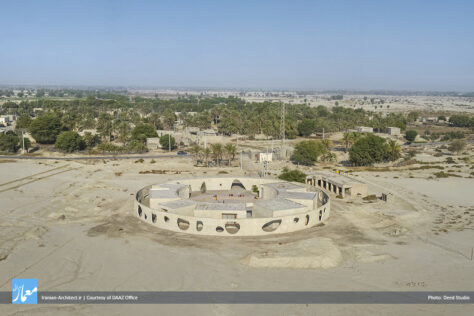
در راستای توسعه پایدار، ابتدا با مشارکت تسهیلگران اجتماعی، کارهای زیرساختی مشارکتمحور در روستا انجام شد، از قبیل دعوت اهالی برای حفظ بهداشت و نظافت روستا، ایجاد سپتیک فاضلاب، و همچنین راهاندازی کارگاه سوزندوزی و صفحه اینستاگرام بانوک برای معرفی و فروش محصولات کارگاه. به این ترتیب، نه تنها بانوان روستا وارد فعالیتهای اجتماعی و تاثیرگذار شدند، بلکه موجب دیدهشدن آنها و موثربودن حضورشان در لایههای اجتماعی و اقتصادی روستا شد. همچنین اهالی روستا به عنوان نیروی کار، و نیز با اهدای درآمدهایشان از فروش محصولات سوزندوزی، در روند ساخت پروژه مشارکت کردند. بدینترتیب، مدرسه با یک مشارکت همگانی و تعلق خاطر جمعی ساخته شد.

مدرسه روستای سیدبار شامل چهار کلاس ابتدایی با ابعاد متفاوت و با قابلیت ادغام در هم، یک کتابخانه، یک سالن چندمنظوره (سالن اجتماعات و امتحانات، و کارگاه سوزندوزی بانوک) و حیاطهای فرعی و اصلی است که با هدف تبدیلشدن به مرکز محله و نیز مرکزی برای آموزش و فرهنگسازی در کل روستا طراحی شده است. با توجه به جمعیت دانشآموزان و تعداد معلم در روستا، و طبق ضوابط سازمان نوسازی مدارس، مدرسه به چهار کلاس نیاز داشت که آنها را در دو گروه دوتایی، شامل یک کلاس بزرگ و یک کلاس کوچک که با هم مرتبط هستند، طراحی کردیم، به گونهای که یک فضای بینابین در کلاس بزرگتر وجود دارد که دانشآموزان کلاس کوچک میتوانند در آنجا حضور داشته باشند تا هم از آموزش توسط یک معلم (به دلیل محدودیت تعداد معلم) بهرهمند شوند و هم با سالبالاییهای خود تعامل داشته باشند.
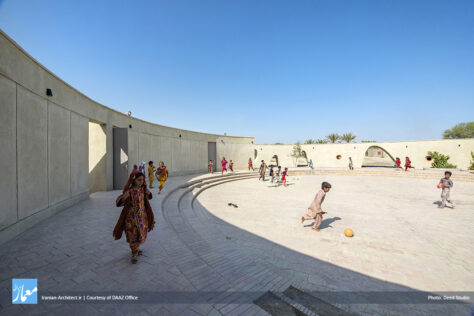
فرم دایرهشکل حیاط مدرسه و نحوه قرارگیری کلاسها با ایده «آموزش به معنای یادگیری در کنار هم و بدون سلسلهمراتب» شکل گرفت. چرخش کلاسها و اتصال آنها از گوشه به یکدیگر، علاوه بر اینکه موجب گردش هوا مابین کلاسها میشود، حیاطهای کوچکی را مابین آنها برای کارهای گروهی و فعالیتهای بیرونی تولید میکند. در واقع، با این سازماندهی، به یک حیاط مرکزی به عنوان محل تجمع دانشآموزان مدرسه و مردم روستا، یک فضای گردشی پیرامونی بین دیوار و کلاسها، و چند حیاط خصوصی دست پیدا کردیم.
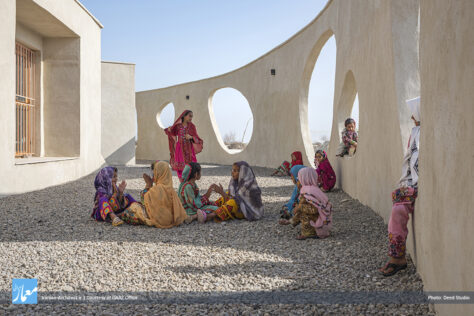
دیوار به شکل مرسوم در مدارس، به عنوان حفاظ، جداکننده و حصار است؛ اما در این پروژه، به واسطه قرارگیری آن در دشتی وسیع، دیوار مدرسه را به عنوان یک پوسته متخلخل، دعوتکننده و بازیگوش طراحی کردیم. گشودگیهای دیوار به گونهای است که از پنجره کلاسها، امتداد دید به سمت دشت وجود دارد، و ابعاد مختلف گشودگیها امکان ورود به مدرسه از سمتهای مختلف را برای دانشآموزان فراهم میکند. همچنین با افزایش ضخامت دیوار در ورودی، علاوه بر ایجاد عمق در طاقهای ورودی و دعوتکنندگی در لحظه ورود، عملکردهای خدماتی مانند سرایداری، بوفه و انبار را در دل دیوار قرار دادیم.
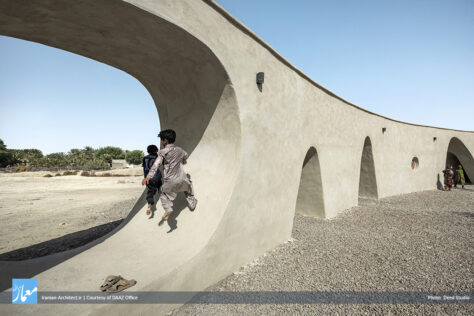
در طراحی مدرسه سعی کردیم که آموزش را امری دیالوگمحور، دوطرفه و مشارکتی ببینیم. بنابراین فضاهای مرسوم مدرسه را که بستر این نگرش هستند، بر این اساس ساماندهی کردیم: دیوار مدرسه را از یک دیوار جداکننده به یک پوسته و جداره متخلخل، بیمرز، دعوتکننده و شاد تغییر دادیم، و حیاط را برای تجمع و دیالوگ، و کلاسها را برای پرسشگری و از بین بردن سلسلهمراتب تعریف کردیم تا سادهترین مفهوم مدرسه را که «باهم بودن» است، نشان دهیم، و بر این باور هستیم که این مدرسه میتواند به فضایی برای پرورش فکر، خلاقیت و آزاداندیشی تبدیل شود.
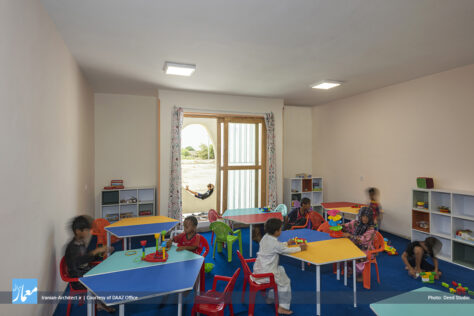
سیستم سازهای با توجه به ضوابط سازمان نوسازی مدارس و برای مقاومبودن در برابر زلزله، ICF (Insulating Concrete Formwork) در نظر گرفته شد که با استفاده از پنلهای پلیاستایرن (EPS)، پروفیلهای گالوانیزه و بتن مسلح، و بدون ستون (بهواسطه وجود فرمهای منحنیشکل) ساخته شده است. پوشش نهایی بنا نیز از متریال نیمهبومی با ترکیبی از سیمان و خاک منطقه (سیمگل) است که جلوی خوردگی سنتی نما توسط باران و سیلاب را میگیرد، و همچنین با رنگ و بافت محیط یکی است.
Jadgal Elementary School
DAAZ Office (Arash Aliabadi)
Location: Seyyed Bar Village, Chabahar, Sistan & Baluchestan, Iran
Date: 2020
Area: 480 sqm
Status: Completed
Client: Iran-e-Man NGO
Design Team: Mahsa Hosseini, Nazanin Mojahed
Social Facilitator: Mina Kamran
Structure: A. Giahi
MEP Engineering: A. Delavar
Construction: A. Noghrehkar
Supervision: Mehran Goodarzyar, Mahsa Hosseini, Arash Aliabadi
Photo: Deed Studio
The project began with an open call from a school building NGO and the request of the people and teachers of Seyeyd Bar village from this organization, to build a school in the area. At first, the analysis of the location and its requirements, the consideration of the existing situation and its condition were our foremost concern. Considering that this project had a limited budget and was to be built only by people’s donations, we did not plan “a build and donate” scenario, and rather opted for a participation method of construction that would promote sustainable development and produce social, economic, and cultural infrastructures. As a result, we designed a school with the idea of becoming the village and its dependent communities’ development center. In this way, the school was not only a place of education for children, but also a point of gathering and learning for everybody in the village.
In order to materialize this idea and in cooperation with social facilitators, some fundamental works such as doing group work, inviting villagers to maintain the hygiene and cleanliness of the village, building a septic sewage, and setting up a needlework workshop and an Instagram page – called Banook to showcase and sell needlework products – were undertaken. In this way, not only did the women of the village were engaged in social activities, but also it promoted their presence in the social and economic realms of the village, and helped women to be socially seen as more effective. In addition, in coordination with social participation method of development, people of the village helped by working as site labors in the process of building the school. But that was not all they did, as the village families contributed financially and helped by selling needlework in order for the school to materialize. This way, the school was built by public participation, and gained the goodwill of everyone in the village.
Seyyed Bar Village’s school consists of four elementary classes with the ability to combine and overlap with each other, a library, a multi-function hall working as conference room, workshop, or exam hall, and main and secondary play yards that are designed while aiming to become the village’s community center and educate its whole population. Considering the population of the students in relation to teachers in this village, and through adhering to school renovation codes, the school needed four classes. In designing the classes, each two class varying in size, were connected to each other. In the largest class, there is an intermediate space which enables the younger students to join the larger class, taking advantage of the trainings of one single teacher, necessary due to the limitation of teaching personnel, as well as giving them a space to engage with senior students.
The circular form of the school yard and the way classes are arranged were formed with the focal concept of education meaning “learning together” – void of hierarchical systems and in a democratic style. The rotation of the class layout while connecting them on their corners, not only allows for air circulation between the classes, but also produces small secondary yards for doing some group work and outdoor activities. Consequently, with this spacial diagram, we gained a central primary yard in the middle of the school as an assembly point for school children and village residents, a circular space around classes and between the thick penetrated wall and classrooms, as well as private yards.
The concept of a surrounding wall is traditionally understood as protector, separator and generally stands for a masonry built guarding device. In this project, however, through school’s unique location, being in the middle of a relatively flat vast field, the school wall was rather treated as a penetrated inviting playful shell. The openings within the wall are arranged so that from the point of view of a seating person in class, the extension of the surrounding plain can be seen. These openings, having various sizes and shapes, provide students with multi entrances to arrive at the school. Moreover, by increasing the thickness of this continuous yet penetrated wall, some essential functions of the building such as a tuck shop, a school guard’s room, and a store room were housed, while the main entrance was emphasized, gaining depth and inviting people within.
In designing this school, we envisioned education as a dialectic, bilateral, participatory driven concept, and accordingly, the conventional school spaces that act as platforms of these ideas, were transformed in this manner: converting school wall from separator to a shell structure that performs as a penetrated border-less playful skin that invites people to gather and encourages the community culture, while reinforcing communication between people. This transformation was performed in order to destroy hierarchy and strengthen questioning culture, shining light on the most basic meaning of going to school, which is “being together”. In conclusion, we aimed to create a school that is a nest for nurturing creativity, freedom and critical thinking.
The school’s structure, in alliance with the school renovation codes and the necessity of building earthquake-resistant structures, was constructed with ICF (Insulating Concrete Formwork) method, through utilizing polystyrene panels (EPS), galvanized iron profiles, and reinforced concrete; The structure was constructed without using any columns – thanks to the design’s curvilinear forms. The final coating layer that was applied is a semi-local material consisting of cement and local soil called Simgel that prevents rusting due to floods and excessive rain, and creates harmony with the surrounding colors and textures.

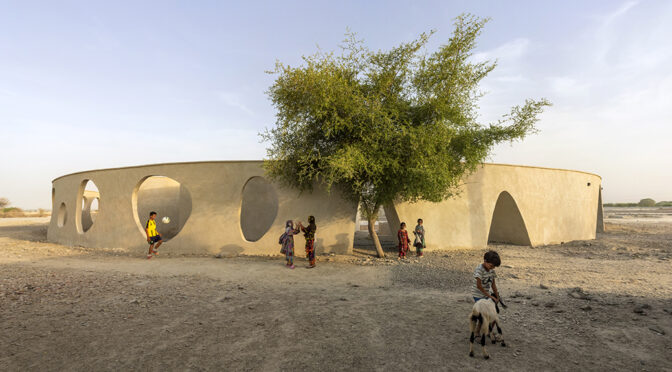
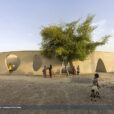
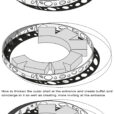
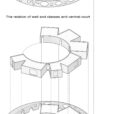
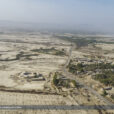

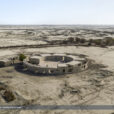
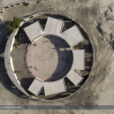
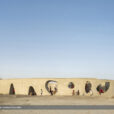
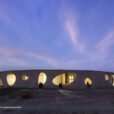
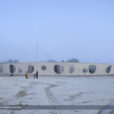
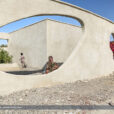
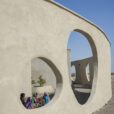
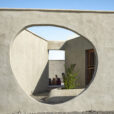
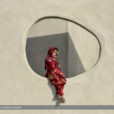
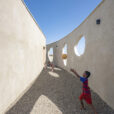
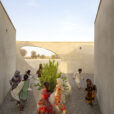
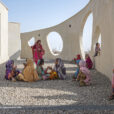
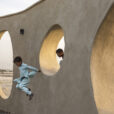
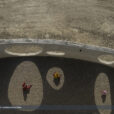
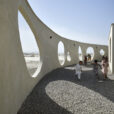
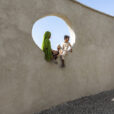
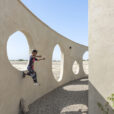
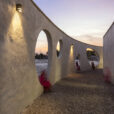
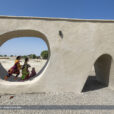
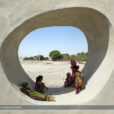
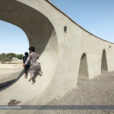
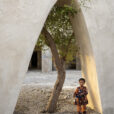
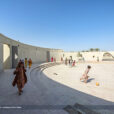
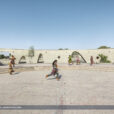
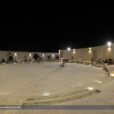
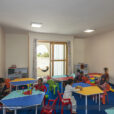
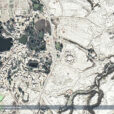
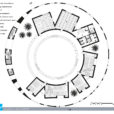
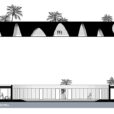
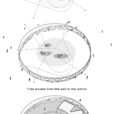
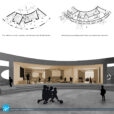
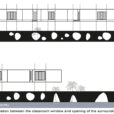
به عنوان یک معلم هنر می گویم:
بسیار خلاقانه است.
یک نکته:
به نظرم اگر دیوارهای انتهایی کلاس دارای انحنا بودند شاید زیباتر می شد.
یک سوال:
آیا حیاط های پشت کلاس ها ، دنج هستند یا از طریق پنجره های کلاس ، در دید اولیای مدرسه قرار دارند؟